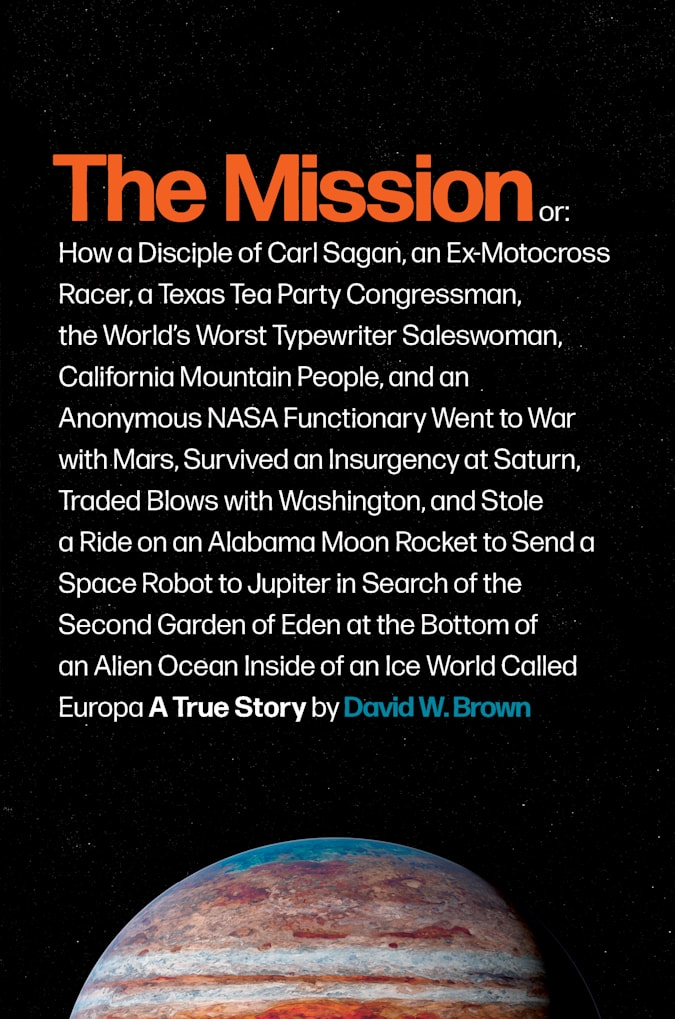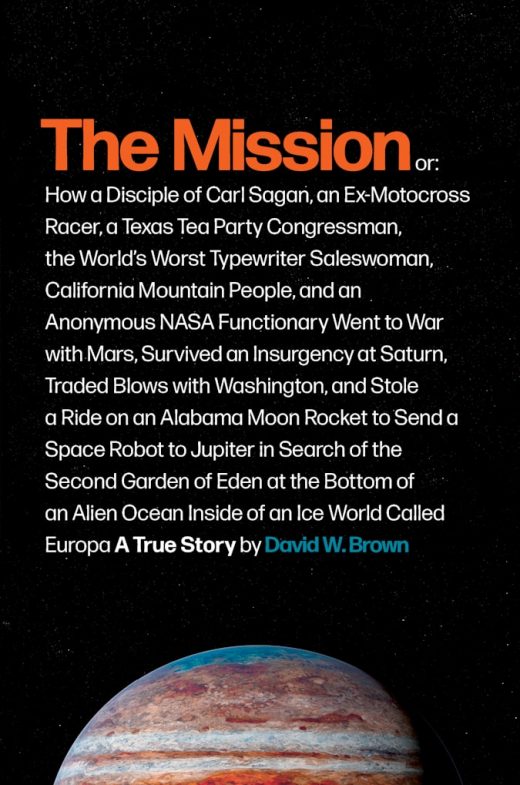Hitting the Books: How NASA survived the Reagan era ‘Dark Ages’
Hitting the Books: How NASA survived the Reagan era ‘Dark Ages’
Going 0-for-a-decade does not for a healthy space agency make.


Excerpted from the book THE MISSION: or: How a Disciple of Carl Sagan, an Ex-Motocross Racer, a Texas Tea Party Congressman, the World’s Worst Typewriter Saleswoman, California Mountain People, and an Anonymous NASA Functionary Went to War with Mars, Survived an Insurgency at Saturn, Traded Blows with Washington, and Stole a Ride on an Alabama Moon Rocket to Send a Space Robot to Jupiter in Search of the Second Garden of Eden at the Bottom of an Alien Ocean Inside of an Ice World Called Europa (A True Story) © 2021 by David W. Brown. From Custom House, a line of books from William Morrow/HarperCollins Publishers. Reprinted by permission.
For planetary scientists, the Jimmy Carter–Ronald Reagan years were in retrospect like the Dark Ages, and they, the monks tending in enclaves to the embers of civilization. For a solid decade starting in late 1978, NASA launched no planetary science missions, and pretty much the only space science data trickling back to Earth came from the Voyager 1 and 2 flybys of the farthest planets of the solar system, where you’d get three weeks of data and then three to five years of silence—hardly enough to sustain an entire field of scientific inquiry. The Voyager findings at Jupiter fueled a desire by the careworn planetary science community to return there, but that required Reagan to fund the spacecraft Galileo—something his administration worked diligently to avoid doing upon assuming power in 1981. The new president believed he had a mandate to slash nondefense spending, and he was following through, and if you weren’t building bombs, battleships, or Black Hawk helicopters, your budget was up for grabs—and grab they did. While NASA’s top line fared well overall, that money was directed largely to the space shuttle program, which had become something of a flying Statue of Liberty in the public imagination. Anyway, the shuttle had military applications, including the deployment of spy satellites and, on paper at least, stealing satellites from foreign governments. The supply-side marauders would still get their squeeze from the agency, however, and that meant science. Before the toner was dry on new presidential letterhead, the White House told NASA that of Galileo, the Hubble Space Telescope, and the joint NASA–European Space Agency International Solar Polar Mission to study the sun, it could keep two (for now). And just like that, Solar Polar was gone. The Europeans had invested in it more than one hundred million dollars, and America thanked them for the trouble by withdrawing without warning, leaving the Europeans seething. The slaughter continued with the spacecraft VOIR, the Venus Orbiting Imaging Radar: vaporized. This cancelation, too, went over poorly. If the Solar Polar abandonment was an uninvited concupiscence thrust upon America’s allies abroad, the Venus cancelation was at least a rude gesture suggesting the same to planetary scientists at home.
But that Galileo mission—how it vexed and annoyed the White House. How the administration wanted this half-billion-dollar monstrosity slain! This expedition to Jupiter . . . we—we’d just been there with Voyager! Why were we even talking about this? So the Office of Management and Budget zeroed out Galileo in its tentative plan for the agency. As for those twin spacecraft Voyager: What, exactly, was there to learn about planets past Saturn, anyway? Uranus! Neptune! Did it matter? I mean, come on! Just issue the shutdown command, and we could also switch off this devil-begotten Deep Space Network as well, those gigantic, twenty-story radio dishes required to talk to them. That’s two hundred twenty-two million dollars saved overnight. Between Galileo and Voyager, we could cut costs by a half billion.
To somehow save what was becoming even to outsiders a sinking ship, the public started pitching in. In one instance, Stan Kent, a California engineer, created what he called the Viking Fund—a private, pass-the-hat effort to cover costs for Deep Space Network downlink time for Viking 1, the last surviving spacecraft on the surface of Mars. Donate now to feed a starving robot—send checks to 3033 Moore Park Ave. #27, San Jose, CA 95128. The Viking program had once been the zenith of NASA space science, the most ambitious agency endeavor since the Apollo program, and, when conceived, a prospective precursor to Apollo’s obvious heir: human missions to planet Mars.
Between 1965 and 1976, NASA had sustained a steady sequence of sophisticated Mars probes. Mariner 4, a flyby in 1965, was humanity’s first successful encounter with the Red Planet. Mariners 6 and 7 followed four years later, imaging up close the entire Martian disc, and those images, stitched together, revealed a real rotating planet—just like Earth. Mariner 9 in 1971 was the first spacecraft to enter orbit around another planet, mapping Mars in high resolution and capturing dust storms and weather patterns. Like elapsing lines in the book of Genesis, each spacecraft in succession made Mars a world as real as our own. By the time the Viking landers left launch pads at Cape Canaveral in 1975, no hope remained for extant alien civilizations, but flora and fauna of some form were still on the table. And the question remained—the ultimate question—the same that had fueled fiction and stirred scientists for centuries: What did that Martian wildlife look like?
The American space program has always marched inexorably toward Mars. Before the Eagle landed—before even the first naut—cosmo, taiko, or astro—before Sputnik—before even the formation of NASA itself—there was Das Marsprojekt, a work of speculative fiction by Wernher von Braun, the German rocket scientist relocated to the United States immediately after World War II. No mere thought experiment or flight of fancy—no ray guns, no saucermen—the plot was a thin veneer over How to Do It, and the author was the person most likely to make it happen. Von Braun wrote Das Marsprojekt in 1948 after finishing work reconstructing for his new American hosts the V-2 rocket, a ballistic missile he helped develop during the war. The book was later stripped of its fictional elements and repurposed as a nine-page article in the April 30, 1954, issue of Collier’s Weekly, then one of the most popular and prestigious magazines in the United States. The first serious study of how to get to Mars, von Braun’s plan involved a space station and a flotilla of reusable rockets and shuttles, and necessitated a crew of seventy strong for a Martian stay exceeding one Earth year. Upon arrival, astronauts (well, “spacemen”—astronauts had not yet been invented) would enter orbit and scout suitable set-down sites for the human beachhead. (He didn’t discuss robotic exploration because digital, programmable robots had not yet been invented, either.)
For von Braun, Mars was always the plan, the moon merely a waypoint, and fourteen years later, when Armstrong leapt from that bottom rung of the lunar lander ladder, it was von Braun’s Saturn V rocket that got him there. He (i.e., von Braun) was by then director of NASA Marshall Space Flight Center in Huntsville, Alabama, de facto “father of the American space program,” and a minor celebrity. He had made multiple appearances years earlier on a 1950s television show called Disneyland—hosted by Walt himself—selling to forty million Americans the notion of robust, reliable rockets, moon shots, and Mars colonies. When the shows aired, Yuri Gagarin was still an obscure pilot in the Soviet air force, and Alan Shepard a test pilot in Maryland. To the extent that Americans were even aware of U.S. space ambitions, it was von Braun soft selling Mars missions with Walt Disney. He had been working toward this for a very long time.
It was thus unsurprising that two weeks after American silicon soles pressed prints into fresh moondust, von Braun stepped into Spiro Agnew’s office and slapped onto the vice president’s desk the next natural frontier for American exploration: the Red Planet. The fifty-page presentation—the definitive plan to make mankind multiplanetary—represented the culmination of von Braun’s life’s work. His prescription involved many of the elements he had proposed decades earlier: the rockets, the shuttles, the station—even a nuclear-powered spaceship.
Unfortunately for von Braun, prevailing forces in Congress and the White House came quickly to see the Apollo program as the goal, rather than, as he had hoped, an early milestone of something much larger. You didn’t build Hoover Dam and then… build more Hoover Dams downriver, said the politicians. We set a goal, and by God we did it. Why even have a NASA? wondered the White House aloud. By Apollo 15 in 1971, opinion polls pegged public support of space spending at about twenty-three percent, with sixty-six percent saying that spending was too high. There would be no national political price for closing Cape Canaveral completely. Really, what were we doing up there?
Nevertheless, von Braun’s sequence of space missions culminating in Mars exploration had so defined NASA that it was almost hardwired into the system. Nixon, having zero interest in the space program but even zeroer interest in being the one who ended it, entertained only the space shuttle element as viable because it 1. had those spy satellite applications and 2. Could be a major construction project in Palmdale, California, keeping his home state in his column during the next presidential campaign. So the California-made, satellite-stealing space shuttle it was! NASA lived to flight another day.
(34)


